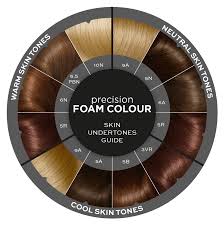Decoding the Art of Hair Color: A Guide to the Hair Color Wheel
Enter the world of hair color mastery by understanding the principles of the hair color wheel. This essential tool serves as a compass for hairstylists and enthusiasts alike, guiding the creation of harmonious and visually appealing hair color combinations. Join us as we demystify the hair color wheel, unlocking the secrets to achieving your desired hues with confidence.
Body:
- Primary Colors: Just like the traditional color wheel, the hair color wheel begins with primary colors – red, blue, and yellow. These hues are the building blocks for creating a wide range of secondary and tertiary shades.
- Secondary Colors: Mixing primary colors leads to the formation of secondary colors. In the hair color world, these are orange (red + yellow), green (blue + yellow), and violet (red + blue). Understanding these combinations helps in achieving specific tones when coloring hair.
- Tertiary Colors: Tertiary colors result from mixing a primary color with a neighboring secondary color. For example, red-orange and blue-green are tertiary colors. This level of detail becomes crucial when aiming for nuanced and customized hair colors.
- Complementary Colors: Colors opposite each other on the hair color wheel are considered complementary. When used together, complementary colors create contrast and vibrancy. Stylists often use this principle to neutralize or enhance certain tones in the hair.
- Analogous Colors: Analogous colors, found next to each other on the hair color wheel, share similar undertones. Using analogous colors creates a harmonious and blended effect, perfect for achieving natural-looking hair color transitions.
- Warm and Cool Tones: One of the key distinctions on the hair color wheel is between warm and cool tones. Warm tones, such as reds and yellows, add warmth and vibrancy, while cool tones, like blues and greens, impart a cooler and more subdued effect.
- Depth and Intensity: The hair color wheel also helps in understanding the depth and intensity of colors. Shades closer to the center of the wheel are considered less intense, while those toward the outer edges are more vibrant and bold.
 Mastering the art of hair coloring begins with a solid understanding of the hair color wheel. Whether you’re a hairstylist or someone exploring DIY hair color options, this guide empowers you to make informed choices, create harmonious blends, and express your unique style through the language of color. Let the hair color wheel be your trusted companion on the journey to achieving the perfect hair hue.
Mastering the art of hair coloring begins with a solid understanding of the hair color wheel. Whether you’re a hairstylist or someone exploring DIY hair color options, this guide empowers you to make informed choices, create harmonious blends, and express your unique style through the language of color. Let the hair color wheel be your trusted companion on the journey to achieving the perfect hair hue.
Ready to embark on your color journey? Consult with our experienced stylists to explore the endless possibilities that the hair color wheel offers. Transform your hair into a canvas of vibrant expression and discover the beauty of color in every strand.